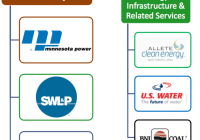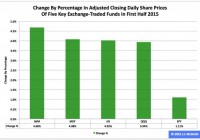Invest In America With These 4 ETFs
Now more than ever, it is a great time to invest in the United States. Foreign concerns are piling up around the world and a number of global economies appear to be teetering on the brink of more turmoil. Greece threatens to take the rest of Europe down with it in a debt spiral that could put extra focus on the rest of the eurozone peripheral economies in the process. China is also on the brink, as its latest steps seem unable to stave off a stock market slide in what had been one of the hottest corners of the globe to start the year. Meanwhile, here in the U.S., stocks are holding steady while we are seeing reasonably positive data on multiple fronts as well. Consumers remain confident, oil prices are moderate, construction spending is rising and unemployment remains a very small problem for many. As you can see by the preceding paragraphs, there is quite the difference between what is going on in the U.S. and what is happening in the rest of the major economies of the world. And this doesn’t even go into the peril that many emerging markets – or even commodity-focused nations – find themselves in right now. So if you are looking to make a targeted investment in the U.S., consider any of the four ETFs outlined below. These picks go across asset classes so there should be something for every investor who is looking to bet on the United States of America in a portfolio: First Trust RBA American Industrial Renaissance ETF (NASDAQ: AIRR ) If you are looking to bet on a resurgence in American industrial might and production, AIRR is a great choice. The fund focuses on small and mid cap stocks in the industrial and community banking sectors. The index starts with Russell 2500 index components and then eliminates all those that aren’t related to manufacturing or related infrastructure, as well as banking. Companies are then screened out which do more than one-quarter of their business beyond U.S. shores, or have a negative forward PE. For the banking component, only banks in traditional manufacturing hubs will be included in the holdings list. This approach looks to focus on small and midsized manufacturing companies that are selling to other U.S. firms or customers. And the banking component not only provides diversification, but acts as a secondary way to play a manufacturing boom as many small cap industrial companies will look here for their capital needs. PowerShares Build America Bond Portfolio ETF (NYSEARCA: BAB ) The Build America Bond program consists of taxable muni bonds which come with a 35% interest rate subsidy, paid to the issuer. This makes these taxable securities competitive on a cost and yield perspective for issuers and a solid choice for muni bond investors. And though the program ended as part of the American Recovery and Reinvestment Act, there are still plenty of these bonds outstanding, making them excellent ways to invest in America from a fixed income perspective. Investors should note that the duration is a bit high here coming in at just under 10 years, so interest rate risk is definitely something to consider. However, with the recent Greek issues, a rate hike could be postponed in the near term. And with a 30-day SEC Yield of about 4.2%, it definitely is an income destination. It has been a weak run for BAB as of late, but you can say that about many muni bond ETFs in the past few months, and especially those with more interest rate risk. However, if you are looking for a different type of muni bond ETF – and particularly one in the taxable market – BAB and the Build America Bond market will be tough to beat for betting on America in a fixed income portion of a portfolio. Teucrium Corn ETF (NYSEARCA: CORN ) The United States is the world’s biggest producer of corn by far, producing nearly as much as China, Brazil, and the entire EU bloc combined. And for exports, there is a similar story brewing with the U.S. easily leading the pack. This makes corn a great crop to invest in if you are looking to make a play on a U.S.-centric natural resource. Investors can play this commodity with the Teucrium Corn ETF which sees a decent amount of volume and AUM approaching $100 million. The fund doesn’t just invest in front month corn futures though, as it includes second to expire CBOT futures, third to expire futures, and then the December futures following the expiration month of the third to expire contact. Though the commodity is down against the S&P 500 through the first half of the year, it is slowly making a comeback and has gained about 13% in the past month. This big gain is due to a great crop report so be on the lookout for CORN later this summer as well. PowerShares DB USD Bull ETF (NYSEARCA: UUP ) Thanks to more global central bank easing and demand for safe havens, the U.S. dollar has been a strong performer as of late. And speculation that a rate hike could be coming at some point soon is certainly something that can’t be said for a number of other central banks out there which are moving in the other direction. You can easily bet on continued dollar strength with UUP though, as this ETF offers exposure that goes long in USDX futures against a variety of developed market currencies. The euro constitutes about 58% of the benchmark, 13% goes to yen, and then 11.9% is in British pounds and 9% in Canadian dollars. The fund is thus heavily dependent on the performance of the dollar against the euro but this has been a great trade for a while and could continue to be as long as the European debt crisis persists. Plus with a Zacks ETF Rank #2 (Buy), the longer term picture is looking bright for this ETF too. Original Post

